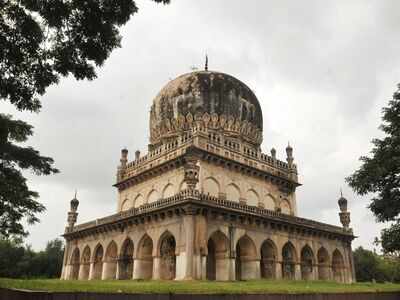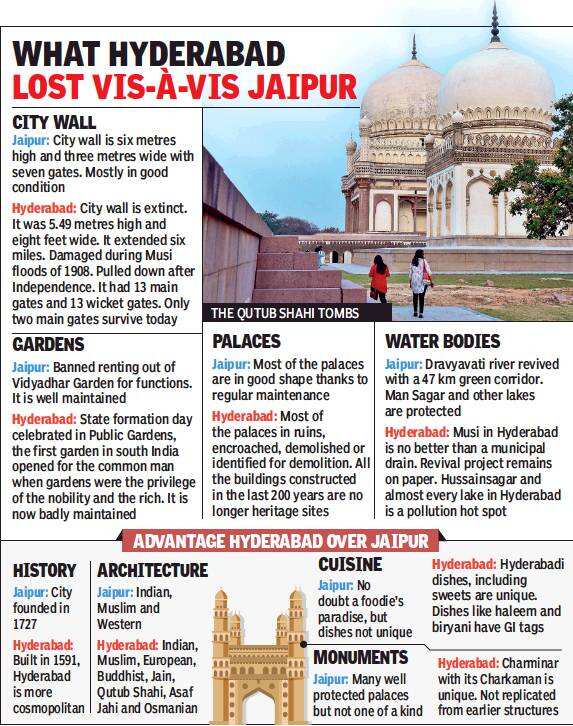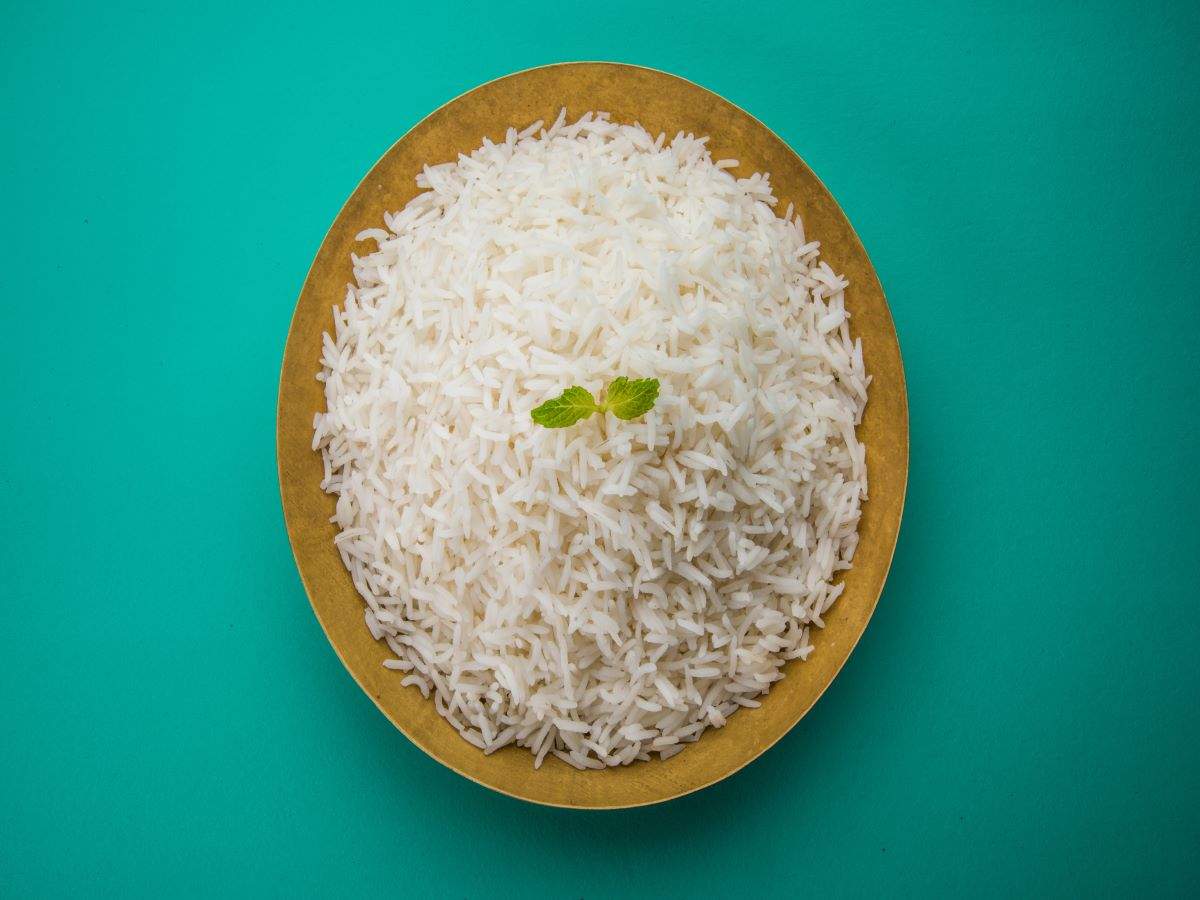
The World Heritage Committee of Unesco, in its citation following the declaration of Jaipur as a heritage city, broadly refers to six criteria for selecting the pink city. A study of these factors that catapulted Jaipur to a world heritage city makes Hyderabad a fit case for the coveted tag.
Albeit, the dossier on some of the monuments of Hyderabad has been gathering dust in the Unesco cupboards for the past nine years as the state government did not pursue it. Since the dossier was first made in favour of Hyderabad in 2010, most heritage structures in the city have been delisted, withdrawing government protection. Heritage experts demand that the state government resubmit the dossier seeking heritage status for the erstwhile walled city of Hyderabad.

The first criterion cited by Unesco for Jaipur reads: “Unlike other cities in the region located in hilly terrain, Jaipur was established on the plain and built according to a grid plan interpreted in the light of Vedic architecture.”
This criterion applies to Hyderabad too. When the new city of Hyderabad was planned to depopulate the congested fort city of Golconda, in 1591, the ruler, Mohammad Quli Qutub Shah, selected a plain on the other bank of river Musi. It was constructed on a grid plan inspired by city of Isfahan, considered as heaven on earth. The Qutub Shahis adopted a new style of architecture that became popular after their dynasty. It is a blend of Indian (Vedic) and Islamic styles.
The second factor in favour of Jaipur was “the streets feature continuous collonaded businesses that intersect in the centre, creating large public squares called chaupars. The old city of Hyderabad, too, boasts such public squares. In fact, Charminar and Gulzar Houz were the first public squares here. The Charkaman served as entry points to the now extinct Qutub Shahi palaces.
The Unesco citation refers to “markets, stalls, residences and temples built along the main streets having uniform facades”, as one of the criteria. The Pathergatti in Hyderabad was constructed to provide a uniform façade to one of the city’s oldest shopping complexes built entirely of granite, lending the name — Pathergatti.
The fourth factor cited by Unesco was Jaipur’s “urban planning showing an exchange of ideas from ancient Hindu and modern Mughal as well as Western cultures”. No city in India beats Hyderabad when it comes to the blend of cultures — Hindu, Muslim, Buddhist, Jain and Western.
In fact, Hyderabad had resurrected Ajanta and Ellora architecture by incorporating some principles in buildings constructed during the reign of last Nizam, Mir Osman Ali Khan. This blend has come to be known as the Osmanian style of architecture, quite different from the one followed by earlier rulers. The fifth criterion is that Jaipur’s grid plan is a “model that prevails in the West, while the organization of different districts refers to traditional Hindu concepts”. The grid plan of Hyderabad, when it was founded, was based on Persian city of Isfahan. Hyderabad boasts of traditional Hindu and Muslim concepts on one hand, and Indian and Persian concepts on the other.
“Designed to be a commercial capital, the city (Jaipur) has maintained its local commercial, artisanal and cooperative traditions to this day”, reads the last of the factors for Jaipur. Hyderabad being a metropolitan city from the day it was founded is a bigger commercial capital. Hyderabad continues to maintain local commercial, artisanal, and cooperative traditions though on a global scale, bigger than that of Jaipur.
City heritage experts point out that if there is an area where Hyderabad stands behind Jaipur and Ahmedabad, it is the negligence of monuments. Hyderabad will lose Asaf Jahi and Osmanian styles of architecture as all the buildings constructed in these styles have been delisted, and they are no longer protected or “heritage” monuments, regrets city INTACH convener P Anuradha Reddy.
Albeit, the dossier on some of the monuments of Hyderabad has been gathering dust in the Unesco cupboards for the past nine years as the state government did not pursue it. Since the dossier was first made in favour of Hyderabad in 2010, most heritage structures in the city have been delisted, withdrawing government protection. Heritage experts demand that the state government resubmit the dossier seeking heritage status for the erstwhile walled city of Hyderabad.

The first criterion cited by Unesco for Jaipur reads: “Unlike other cities in the region located in hilly terrain, Jaipur was established on the plain and built according to a grid plan interpreted in the light of Vedic architecture.”
This criterion applies to Hyderabad too. When the new city of Hyderabad was planned to depopulate the congested fort city of Golconda, in 1591, the ruler, Mohammad Quli Qutub Shah, selected a plain on the other bank of river Musi. It was constructed on a grid plan inspired by city of Isfahan, considered as heaven on earth. The Qutub Shahis adopted a new style of architecture that became popular after their dynasty. It is a blend of Indian (Vedic) and Islamic styles.
The second factor in favour of Jaipur was “the streets feature continuous collonaded businesses that intersect in the centre, creating large public squares called chaupars. The old city of Hyderabad, too, boasts such public squares. In fact, Charminar and Gulzar Houz were the first public squares here. The Charkaman served as entry points to the now extinct Qutub Shahi palaces.
The Unesco citation refers to “markets, stalls, residences and temples built along the main streets having uniform facades”, as one of the criteria. The Pathergatti in Hyderabad was constructed to provide a uniform façade to one of the city’s oldest shopping complexes built entirely of granite, lending the name — Pathergatti.
The fourth factor cited by Unesco was Jaipur’s “urban planning showing an exchange of ideas from ancient Hindu and modern Mughal as well as Western cultures”. No city in India beats Hyderabad when it comes to the blend of cultures — Hindu, Muslim, Buddhist, Jain and Western.
In fact, Hyderabad had resurrected Ajanta and Ellora architecture by incorporating some principles in buildings constructed during the reign of last Nizam, Mir Osman Ali Khan. This blend has come to be known as the Osmanian style of architecture, quite different from the one followed by earlier rulers. The fifth criterion is that Jaipur’s grid plan is a “model that prevails in the West, while the organization of different districts refers to traditional Hindu concepts”. The grid plan of Hyderabad, when it was founded, was based on Persian city of Isfahan. Hyderabad boasts of traditional Hindu and Muslim concepts on one hand, and Indian and Persian concepts on the other.
“Designed to be a commercial capital, the city (Jaipur) has maintained its local commercial, artisanal and cooperative traditions to this day”, reads the last of the factors for Jaipur. Hyderabad being a metropolitan city from the day it was founded is a bigger commercial capital. Hyderabad continues to maintain local commercial, artisanal, and cooperative traditions though on a global scale, bigger than that of Jaipur.
City heritage experts point out that if there is an area where Hyderabad stands behind Jaipur and Ahmedabad, it is the negligence of monuments. Hyderabad will lose Asaf Jahi and Osmanian styles of architecture as all the buildings constructed in these styles have been delisted, and they are no longer protected or “heritage” monuments, regrets city INTACH convener P Anuradha Reddy.
World Cup 2019
Trending Topics
LATEST VIDEOS
More from TOI
Navbharat Times
Featured Today in Travel
Quick Links
Lok Sabha Election Schedule 2019Lok Sabha Election NewsDelhi Capitals teamMI team 2019Rajasthan Royals 2019RCB team 2019Maharashtra Lok Sabha ConstituenciesBJP Candidate ListBJP List 2019 TamilnaduShiv Sena List 2019AP BJP List 2019Mamata BanerjeeBJP List 2019 MaharashtraPriyanka GandhiBJP List 2019 KarnatakaAMMK Candidate List 2019BJP List 2019 WBLok Sabha Elections in Tamil NaduBSP List 2019 UPNews in TamilLok Sabha Poll 2019Satta Matka 2018PM ModiMahagathbandhanNagpur BJP Candidate ListChandrababu NaiduTamil Nadu ElectionsUrmila MatondkarNews in TeluguMadras High CourtTejashwi YadavArvind KejriwalTejasvi SuryaPawan KalyanArvind KejriwalYogi AdityanathJaya PradaSatta King 2019Srinagar encounter
Get the app









